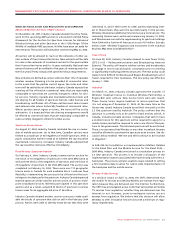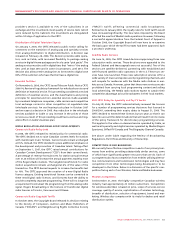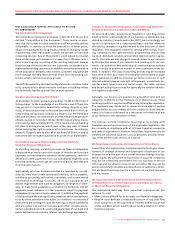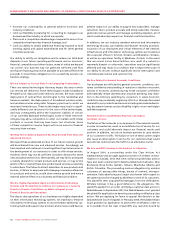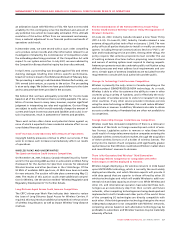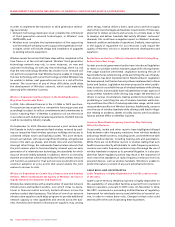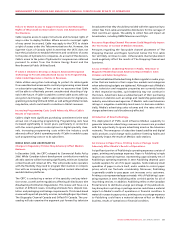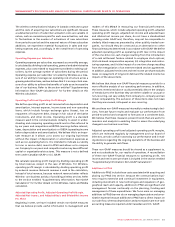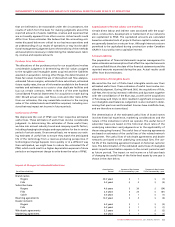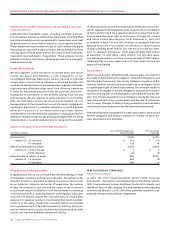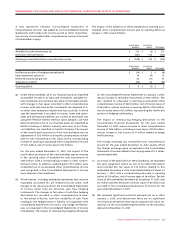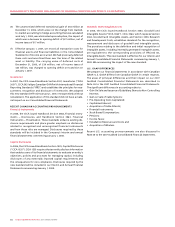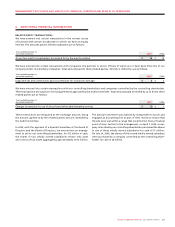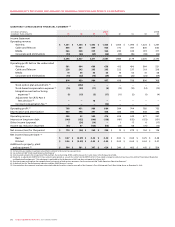Rogers 2007 Annual Report Download - page 65
Download and view the complete annual report
Please find page 65 of the 2007 Rogers annual report below. You can navigate through the pages in the report by either clicking on the pages listed below, or by using the keyword search tool below to find specific information within the annual report.
ROGERS COMMUNICATIONS INC. 2007 ANNUAL REPORT 61
MANAGEMENT’S DISCUSSION AND ANALYSIS OF FINANCIAL CONDITION AND RESULTS OF OPERATIONS
The wireless communications industry in Canada continues to grow
and the costs of acquiring new subscribers are significant. Because
a substantial portion of subscriber activation costs are variable in
nature, such as commissions paid for each new activation, and due
to fluctuations in the number of activations of new subscribers
from period-to-period and the seasonal nature of these subscriber
additions, we experience material fluctuations in sales and mar-
keting expenses and, accordingly, in the overall level of operating
expenses.
Operating Expense per Subscriber
Operating expense per subscriber, expressed as a monthly average,
is calculated by dividing total operating, general and administrative
expenses, plus costs related to equipment provided to existing sub-
scribers, by the average number of subscribers during the period.
Operating expense per subscriber is tracked by Wireless as a mea-
sure of our ability to leverage our operating cost structure across a
growing subscriber base, and we believe that it is an important mea-
sure of our ability to achieve the benefits of scale as we increase the
size of our business. Refer to the section entitled “Supplementary
Information: Non-GAAP Calculations” for further details on this
Wireless calculation.
Operating Profit and Operating Profit Margin
We define operating profit as net income before depreciation and
amortization, interest expense, income taxes and non-operating
items, which include foreign exchange gains (losses), loss on
repayment of long-term debt, change in fair value of derivative
instruments, and other income. Operating profit is a standard
measure used in the communications industry to assist in under-
standing and comparing operating results and is often referred to
by our peers and competitors as EBITDA (earnings before interest,
taxes, depreciation and amortization) or OIBDA (operating income
before depreciation and amortization). We believe this is an impor-
tant measure as it allows us to assess our ongoing businesses
without the impact of depreciation or amortization expenses as
well as non-operating factors. It is intended to indicate our ability
to incur or service debt, invest in PP&E and allows us to compare
our Company to our peers and competitors who may have different
capital or organizational structures. This measure is not a defined
term under Canadian GAAP or U.S. GAAP.
We calculate operating profit margin by dividing operating profit
by total revenue, except in the case of Wireless. For Wireless,
operating profit margin is calculated by dividing operating profit
by network revenue. Network revenue is used in the calculation,
instead of total revenue, because network revenue better reflects
Wireless’ core business activity of providing wireless services. Refer
to the section entitled “Supplementary Information: Non-GAAP
Calculations” for further details on this Wireless, Cable and Media
calculation.
Adjusted Operating Profit, Adjusted Operating Profit Margin,
Adjusted Net Income, and Adjusted Basic and Diluted Net Income
Per Share
Beginning in 2007, we have included certain non-GAAP measures
that we believe provide useful information to management and
readers of this MD&A in measuring our financial performance.
These measures, which include adjusted operating profit, adjusted
operating profit margin, adjusted net income and adjusted basic
and diluted net income per share, do not have a standardized
meaning under GAAP and, therefore, may not be comparable to
similarly titled measures presented by other publicly traded com-
panies, nor should they be construed as an alternative to other
financial measures determined in accordance with GAAP. We define
adjusted operating profit as operating profit less: (i) the impact
of the one-time non-cash charge resulting from the introduction
of a cash settlement feature related to employee stock options;
(ii) stock-based compensation expense; (iii) integration and restruc-
turing expenses; and (iv) the impact of a one-time charge resulting
from the renegotiation of an Internet-related services agreement.
In addition, adjusted net income and net income per share excludes
losses on repayment of long-term debt and the related income tax
impacts of the above items.
We believe that these non-GAAP financial measures provide for a
more effective analysis of our operating performance. In addition,
the items mentioned above could potentially distort the analysis
of trends due to the fact that they are either volatile or unusual or
non-recurring, can vary widely from company-to-company and can
impair comparability. The exclusion of these items does not mean
that they are unusual, infrequent or non-recurring.
We use these non-GAAP measures internally to make strategic deci-
sions, forecast future results and evaluate our performance from
period-to-period and compared to forecasts on a consistent basis.
We believe that these measures present trends that are useful to
investors and analysts in enabling them to assess the underlying
changes in our business over time.
Adjusted operating profit and adjusted operating profit margins,
which are reviewed regularly by management and our Board of
Directors, are also useful in assessing our performance and in mak-
ing decisions regarding the ongoing operations of the business and
the ability to generate cash flows.
These non-GAAP measures should be viewed as a supplement to,
and not a substitute for, our results of operations. A reconciliation
of these non-GAAP financial measures to operating profit, net
income and net income per share is included in the section entitled
“Supplementary Information: Non-GAAP Calculations”.
Additions to PP&E
Additions to PP&E include those costs associated with acquiring and
placing our PP&E into service. Because the communications busi-
ness requires extensive and continual investment in equipment,
including investment in new technologies and expansion of geo-
graphical reach and capacity, additions to PP&E are significant and
management focuses continually on the planning, funding and
management of these expenditures. We focus more on managing
additions to PP&E than we do on managing depreciation and amor-
tization expense because additions to PP&E have a direct impact on
our cash flow, whereas depreciation and amortization are non-cash
accounting measures required under Canadian and U.S. GAAP.


